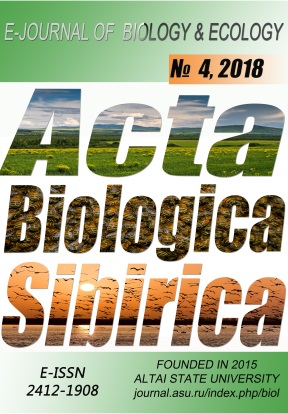Аннотация
В работе представлены результаты исследования морфологических признаков и распространения в Восточной Азии Viscum coloratum (Kom.) Nakai с целью выявить специфические признаки этого вида и установить северную и северо-западную границы его ареала. Омела окрашенная на Дальнем Востоке представлена двумя формами: forma lutescens Kitag. и forma rubroaurantiacum (Makino) Kitag. В результате нашего исследования установлено, что северо-западная граница распространения омелы окрашенной достигает в Амурской области долины среднего течения реки Зеи. Впервые отмечается, что на Дальнем Востоке Viscum coloratum произрастает на Quercus mongolica (дуб монгольский). Омела окрашенная обильно поражает деревья липы около лесных пасек и в течение 20 лет заселяет почти все деревья, что вынуждает пчеловодов переносить пасеки в другие места. Среди распространителей плодов Viscum coloratum преобладают обыкновенные и японские свиристели. В народной медицине стран Восточной Азии омела окрашенная используется при лечении гипертонии и онкологических заболеваний. Основными противоопухолевыми веществами в водном экстракте омелы являются лектины.
Литература
Agapova, N.D., Arharova, K.B., Vahtina, L.I., Zemskova, E.A., Tarvis, L.V. (1993). Chisla hromosom cvetkovyh rastenij flory SSSR: semeistva Moraceae–Zygopyllaceae. Saint Petersburg. Nauka (in Russian).
Fedtchenko, B.A. (1936). Viscum L. In: Flora SSSR [Flora of the USSR). Eds. V. L. Komarov. Academy of Sciences of USSR, Moscow – Leningrad, 5, 408–411 (in Russian).
Fruentov, N.K. (1987). Lekarstvennie rasteniya Dalnego Vostoka [Medicinal plants of the Far East). Khabarovskoe knizhnoe izdatelstvo, Khabarovsk (in Russian).
Gurzenkov, N.N. (1973). Issledovanie hromosomhyh chisel rastenij juga Dalnego Vostoka. Komarovskiye chteniya [V.L. Komarov Memorial Lectures) Dalnauka, Vladivostok, 20:47 – 62 (in Russian).
Kharkevich, S.S. (1995). Viscum L. In: Sosudistye rasteniya sovetskogo Dalnego Vostoka [Vascular plants of the Soviet Far East). Ed. S. S. Kharkevich. Nauka, St. Petersburg, 7, 252 (in Russian).
Kitagawa, M. (1979). Neo-Lineamenta Florae Manshuricae. Strauss & Cramer GmbH, Hirschberg
Komarov, V.L. (1903). Flora of Manchuria [Flora Manshuriae). 2(1), St. Peterburg: Gerold (in Russian).
Kurika, A.V., Gorovoy, P.G., Ovodova, R.G., Ovodov, Yu. S., Aifler, R., Knibel, B., Pfyuller, U., Pfyuller, K., Gekeric V. (1998).
Lektini iz Viscum coloratum (videlenie, immunochimicheskaya i phisicochemicheskaya characteristica ). Lesochimia i organicheski syntez: Tez. dokl. III Vseross. sovesch., 28 sent. – 2 okt., 1998. Syktyvkar (in Russian).
Lee, T. B. (1993). Illustrated Flora of Korea. Hyangmunsa, Seoul (in Korean).
Lee, Y. N. (1996). Flora of Korea. Kyohak Publishing Co, Seoul (in Korean).
Li, Peiqiong, Fu, Likuo. (2001). Viscum L. In: Higher Plants of China. Eds: Fu Likuo, Chen Tanqing, Lang Kaiyung, Hong Tao, Lin Qi, Li Rong. Qingdao Publishing House, 7, 760-764.
Maak, R.K. (1861). Puteshestvie po doline reki Ussuri, sovershennoe po porucheniyu sibirskogo otdela imperatorskogo Russkogo georgaficheskogo obshestva [Travellihg through the River Ussuri valley, undertaken on behalf of the Siberian Department of the Imperial Russian Geographical Society). St. Petersburg, 1, (in Russian).
Maksimov, O. B., Kulesh, N.I., Gorovoy, P.G. (2002). Polyphenoly dalnevostochnyh rastenij [Polyphenols in Far East plants). Vladivostok: Dalnauka, (in Russian).
Maximowicz, C.J. (1859). Primitiae florae Amurensis. Versuch einer Flora des Amur, Landes. Mém. Acad. Sci. St. Pétersb. Sav. Etrang. 9, 1.
Melnikova, A.B. (2002). Sosudistye rasteniya zapovednika Bolshekhekhtsirskii [Vascular plants of Bolshekhekhtsirskii Nature reserves). Flora i fauna zapovednikov [Flora and fauna of natural reserves). Moscow, Znanie, 102-128 (in Russian).
Mori, T. (1922). An Enumeration of plants hitherto known from Corea. Juli 1921, published by Government of Chosen, Seoul, Corea
Nakai, T. (1919). Reports on the vegetation of the island Ooryng or Dagelet Island, Corea
Nechaev, V.A. (2008). Ob ecologicheskih svyazah mezhdu pticami i omeloy okrashennoy Viscum coloratum (Kom.) Nauka v Primorye i Priamurye. Russki ornitologicheski Zhurnal [Russian ornithology magazine), 17, 443 – 447 (in Russian).
Nikiticheva, Z.I. (1981). Semeistvo omelovie (Viscaceae). In: Zhuzn rasteni (Life of the Plants). Ed. A.L. Takhtajan. Prosveschenie, Moskwa, 5: 327-329 (in Russian).
Omelko, M.A., Omelko, M.M. (2004). Rol ptic v rasprostranenii rasteni v prirode [The role of birds in plant distribution in the nature). Biological investigation of the Mountain – Taiga Station. Issue 9. Vladivostok: Dalnauka, 9, 178-192. (in Russian).
Park, C. W. (2007). The Genera of Vascular Plants of Korea. Academy Publishing Co., Seoul, Korea
Pharmacopoeia of China (2010). Part 1. Beijing: China Medicinal Sciense and Technology Press (in Chinese).
Qui, Huaxing, Mihael, Gilbert. (2003). Viscum L. In: Flora of China. Eds: Z.Y. Wu, P.H. Raven. Beijing: Science Press & St. Louis: Missouri Botanical Garden Press, 5, 242-245.
Schroeter, A.I. (1975). Lekarstvennaya Flora Sovetskogo Dalnego Vostoka [Medicinal Flora of the Soviet Far East). Moscow, Medicina (in Russian).
Voroshilov, V. N. (1966). Flora sovetskogo Dalnego Vostoka [Flora of the soviet Far East). Nauka, Moscow (in Russian).
Vostrikova, G.G., Vostrikov, L.A. (1971). Medicina narodov Dersu [Medicine of the Dersu people). Khabarovskoe knizhnoe izdatelstvo, Khabarovsk (in Russian).
Xu, Jun-Ping. (2017). Canser Inhibitors from Chinese Natural Medicines. CRC Press. Taylor and Francis Group. Boca Raton, London. New York
Авторы, публикующиеся в данном журнале, соглашаются со следующими условиями:
a. Авторы сохраняют за собой права на авторство своей работы и предоставляют журналу право первой публикации этой работы с правом после публикации распространять работу на условиях лицензии Creative Commons Attribution License, которая позволяет другим лицам свободно распространять опубликованную работу с обязательной ссылокой на авторов оригинальной работы и оригинальную публикацию в этом журнале.
b. Авторы сохраняют право заключать отдельные договора на неэксклюзивное распространение работы в том виде, в котором она была опубликована этим журналом (например, размещать работу в электронном архиве учреждения или публиковать в составе монографии), с условием сохраниения ссылки на оригинальную публикацию в этом журнале. с. Политика журнала разрешает и поощряет размещение авторами в сети Интернет (например в институтском хранилище или на персональном сайте) рукописи работы как до ее подачи в редакцию, так и во время ее редакционной обработки, так как это способствует продуктивной научной дискуссии и положительно сказывается на оперативности и динамике цитирования статьи

